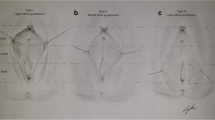Abstract
Introduction and hypothesis
Recurrent post-coital urinary infection (rUTI)—usually cystitis—is a common entity among otherwise healthy young women. However, little is known about the possible influence of genital anatomical variations. Only a shorter urethral meatus-anus distance has been described as a risk factor. The aim of this study was to evaluate our hypothesis that a shorter urethra-vagina distance is involved in the etiology of post-coital urinary infection.
Methods
In this prospective case-control study, 61 young women aged between 18 and 40 years with an acute post-coital UTI and a history of intercourse-related rUTI were consecutively recruited between January 2013 and February 2018. Fifty-six age-matched, sexually active women with no history of UTI served as controls. Perineal measurements included the distances between the clitoris-urethra (C-U), urethra-vagina (U-V), urethra-anus (U-A) and perineum. Demographic and sexual behavior characteristics and the morphology of the urethral meatus were also noted. Univariate analysis compared variables between groups. ROC analysis was used to define the efficiency of perineal measurements in predicting outcome. Odds ratios and 95% confidence intervals for UTI-predisposing variables were estimated using logistic regression analysis.
Results
The U-V and U-A distance was shorter in patients compared with controls [median (interquatile range): 16 mm (14–18) vs. 21 mm (19–23) and 51 mm (47–53) vs. 59 mm (55–62), respectively, p < 0.001]. The U-V performed better in ROC analysis than the U-A distance (AUC 0.952 vs. 0.875, p = 0.023). The only statistically significant parameters in multivariate analysis influencing UTI were BMI (OR: 0.702; 0.510–0.967, p = 0.030) and U-V (OR: 0.297; 0.161–0.549, p < 0.001).
Conclusions
Our results indicate an association between shorter urethra-vagina distance and post-coital rUTIs.




Similar content being viewed by others
References
Aydin A, Ahmed K, Zaman I, Khan MS, Dasgupta P. Recurrent urinary tract infections in women. Int Urogynecol J. 2015;26(6):795–804.
Scholes D, Hooton TM, Roberts PL, Stapleton AE, Gupta K, Stamm WE. Risk factors for recurrent urinary tract infection in young women. J Infect Dis. 2000;182:1177–82.
Griebling TL. Urologic diseases in America project: trends in resource use for urinary tract infections in women. J Urol. 2005;173(4):1281–7.
Arnold JJ, Hehn LE, Klein DA. Common questions about recurrent urinary tract infections in women. Am Fam Physician. 2016;93(7):560–9.
Terlizzi ME, Gribaudo G, Maffei ME. UroPathogenic Escherichia coli (UPEC) infections: virulence factors, bladder responses, antibiotic, and non-antibiotic antimicrobial strategies. Front Microbiol. 2017;8:1566. eCollection 2017
Foxman B, Gillespie B, Koopman J, Zhang L, Palin K, Tallman P, et al. Risk factors for second urinary tract infection among college women. Am J Epidemiol. 2000;151(12):1194–205.
Ishitoya S, Yamamoto S, Mitsumori K, Ogawa O, Terai A. Non-secretor status is associated with female acute uncomplicated pyelonephritis. BJU Int. 2002;89:851–4.
Nseir W, Taha M, Nemarny H, Mograbi J. The association between serum levels of vitamin D and recurrent urinary tract infections in premenopausal women. Int J Infect Dis. 2013;17(12):e1121–4.
Hooton TM, Stapleton AE, Roberts PL, et al. Perineal anatomy and urine-voiding characteristics of young women with and without recurrent urinary tract infections. Clin Infect Dis. 1999;29(6):1600–1.
Gyftopoulos K. The aberrant urethral meatus as a possible aetiological factor of recurrent post-coital urinary infections in young women. Med Hypotheses. 2018;113:6–8.
Haylen BT, Maher CF, Barber MD, Camargo S, Dandolu V, Digesu A, et al. An international urogynecological association (IUGA) / international continence society (ICS) joint report on the terminology for female pelvic organ prolapse (POP). Neurourol Urodyn. 2016;35(2):137–68.
Hanley JA, McNeil BJ. The meaning and use of the area under a receiver operating characteristic (ROC) curve. Radiology. 1982;143(1):29–36.
Cao Y, Li Q, Zhou C, Li F, Li S, Zhou Y. Measurements of female genital appearance in Chinese adults seeking genital cosmetic surgery: a preliminary report from a gynecological center. Int Urogynecol J. 2015;26(5):729–35.
Basaran M, Kosif R, Bayar U, Civelek B. Characteristics of external genitalia in pre- and postmenopausal women. Climacteric. 2008;11(5):416–21.
Lloyd J, Crouch NS, Minto CL, Liao LM, Creighton SM. Female genital appearance: "normality" unfolds. BJOG. 2005;112(5):643–6.
Mira-Escolano MP, Mendiola J, Mínguez-Alarcón L, et al. Longer anogenital distance is associated with higher testosterone levels in women: a cross-sectional study. BJOG. 2014;121(11):1359–64.
Alexander AR, Morrisseau PM, Leadbetter GW. Urethral hymeneal adhesions and recurrent post coital cystitis. Treatment by hymeneoplasty. J Urol. 1972;107:597–8.
Reed JF. Urethral-hymeneal fusion: a cause of chronic adult female cystitis. J Urol. 1970;103:441–6.
Ronzoni G, De Giovanni L, Weir JM, Pasqui F, Menchinelli P. Transposing the urethral meatus in the treatment of recurrent and postcoital cystitis in women with hypospadias. BJU Int. 2001;87(9):894–6.
Nseir W, Farah R, Mahamid M, Sayed-Ahmad H, Mograbi J, Taha M, et al. Obesity and recurrent urinary tract infections in premenopausal women: a retrospective study. Int J Infect Dis. 2015;41:32–5.
Sever N, Oskay U. An investigation of lower urinary tract symptoms in women aged 40 and over. Low Urin Tract Symptoms. 2017;9(1):21–6.
Author information
Authors and Affiliations
Corresponding author
Ethics declarations
Conflicts of interest
None.
Rights and permissions
About this article
Cite this article
Gyftopoulos, K., Matkaris, M., Vourda, A. et al. Clinical implications of the anatomical position of the urethra meatus in women with recurrent post-coital cystitis: a case-control study. Int Urogynecol J 30, 1351–1357 (2019). https://doi.org/10.1007/s00192-018-3710-7
Received:
Accepted:
Published:
Issue Date:
DOI: https://doi.org/10.1007/s00192-018-3710-7



